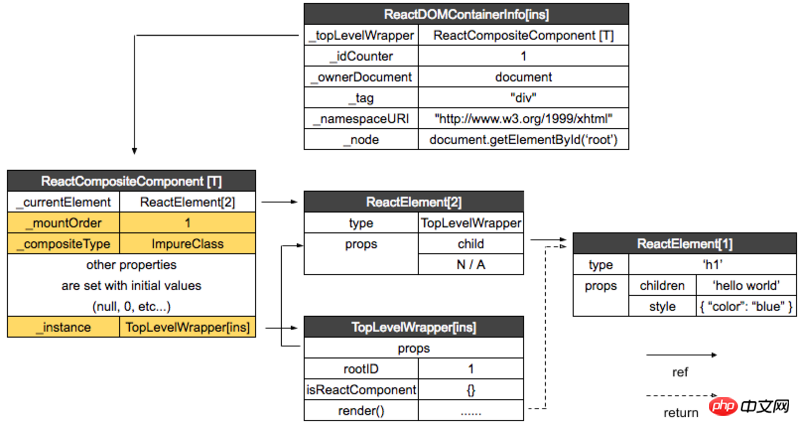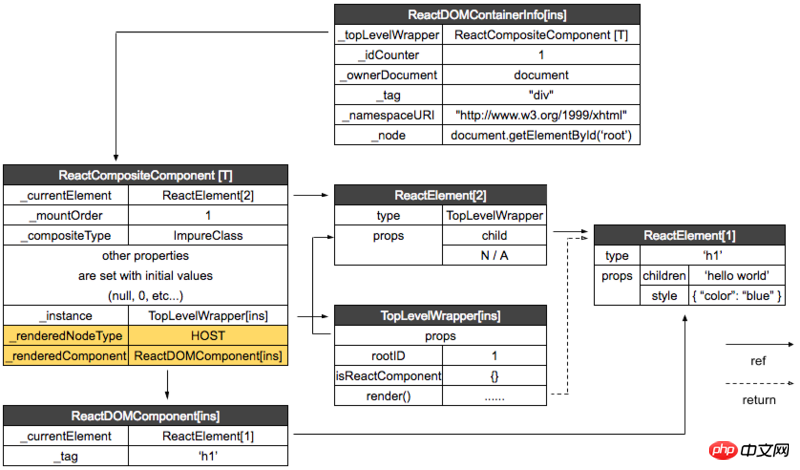React first rendering analysis 2 (pure DOM elements)
The content this article brings to you is about React’s first rendering analysis 2 (pure DOM elements). It has certain reference value. Friends in need can refer to it. I hope it will be helpful to you.
In the previous article, we introduced how the top-level object ReactCompositeComponent[T] is constructed. Next, let’s take a look at what batchedMountComponentIntoNode does.
The call stack that will be explained in this article looks like this:
|=ReactMount.render(nextElement, container, callback) ___ |=ReactMount._renderSubtreeIntoContainer() | |-ReactMount._renderNewRootComponent() | |-instantiateReactComponent() | |~batchedMountComponentIntoNode() upper half |~mountComponentIntoNode() (平台无关) |-ReactReconciler.mountComponent() | |-ReactCompositeComponent.mountComponent() | |-ReactCompositeComponent.performInitialMount() | |-instantiateReactComponent() _|_ |-ReactDOMComponent.mountComponent() lower half |-_mountImageIntoNode() (HTML DOM 相关) _|_
If we look at the source code, we will notice a lot of transaction-related code. We will ignore it for now and will discuss it later. Explained in the article. For the time being, it can be understood that when calling transaction.perform, it is actually a function call on the first parameter. After skipping some template code, what actually does the work is the mountComponentIntoNode method.
// 文件位置:src/renderers/dom/client/ReactMount.js
function mountComponentIntoNode(
wrapperInstance, // ReactCompositeComponent[T]
container, // document.getElementById("root")
transaction,
shouldReuseMarkup,
context
) {
...
var markup = ReactReconciler.mountComponent(
wrapperInstance,
transaction,
null,
ReactDOMContainerInfo(wrapperInstance, container),
context,
0 /* parentDebugID */
);
...
ReactMount._mountImageIntoNode(
markup,
container,
wrapperInstance,
shouldReuseMarkup,
transaction
);
}ReactReconciler.mountComponent is used to create DOM elements, while ReactMount._mountImageIntoNode is the newly created DOM The element is attached to the page. ReactReconciler.mountComponent will call the mountComponent method of ReactCompositeComponent[T]. Before looking at the mountComponent method, you need to prepare hostContainerInfo first, which is generated by ReactDOMContainerInfo:
// 文件位置:src/renderers/shared/stack/reconciler/ReactContainerInfo.js
function ReactDOMContainerInfo(
topLevelWrapper, // ReactCompositeComponent[T]
node // document.getElementById("root")
) {
var info = {
_topLevelWrapper: topLevelWrapper,
_idCounter: 1,
_ownerDocument: node ?
node.nodeType === DOC_NODE_TYPE ? node : node.ownerDocument : null,
_node: node,
_tag: node ? node.nodeName.toLowerCase() : null,
_namespaceURI: node ? node.namespaceURI : null,
};
...
return info;
}The relationship between each instance is now like this:

Continue to look at the mountComponent method:
// 文件位置:src/renderers/shared/stack/reconciler/ReactCompositeComponent.js
mountComponent: function (
transaction,
hostParent,
hostContainerInfo,
context
) {
...
// this._currentElement 为ReactElement[2](TopLevelWrapper)
var publicProps = this._currentElement.props;
var publicContext = this._processContext(context);
// TopLevelWrapper
var Component = this._currentElement.type;
...
// Initialize the public class
var doConstruct = shouldConstruct(Component);
// 生成TopLevelWrapper 实例
var inst = this._constructComponent(
doConstruct,
publicProps,
publicContext,
updateQueue
);
...
var markup;
...
markup = this.performInitialMount(renderedElement,
hostParent, hostContainerInfo, transaction, context
...
return markup;
},
performInitialMount: function (renderedElement, hostParent,
hostContainerInfo, transaction, context) {
// TopLevelWrapper 实例
var inst = this._instance;
...
// If not a stateless component, we now render
if (renderedElement === undefined) {
// 返回值为 ReactElement[1]
renderedElement = this._renderValidatedComponent();
}
// 返回 ReactNodeTypes.HOST
var nodeType = ReactNodeTypes.getType(renderedElement);
this._renderedNodeType = nodeType;
// instantiateReactComponent.js
var child = this._instantiateReactComponent(
renderedElement,
nodeType !== ReactNodeTypes.EMPTY /* shouldHaveDebugID */
);
this._renderedComponent = child;
var markup = ReactReconciler.mountComponent(
child,
transaction,
hostParent,
hostContainerInfo,
this._processChildContext(context),
debugID
);
...
return markup;
},When running to var child = this._instantiateReactComponent, the instantiateReactComponent## mentioned in the previous article will be called. #File:
// 文件位置:src/renderers/shared/stack/reconciler/instantiateReactComponent.js
function instantiateReactComponent(node, shouldHaveDebugID) {
var instance;
...
} else if (typeof node === 'object') {
...
// element.type 为 ‘h1’
if (typeof element.type === 'string') {
instance = ReactHostComponent.createInternalComponent(element);
}
return instance;
}ReactDefaultInjection.inject() during execution to inject ReactDOMComponent into ReactHostComponent. ReactHostComponent.createInternalComponent will eventually call ReactDOMComponent:
// 文件位置:src/renderers/dom/shared/ReactDomComponent.js
function ReactDOMComponent(element) {
// h1
var tag = element.type;
validateDangerousTag(tag);
// ReactElement[1]
this._currentElement = element;
this._tag = tag.toLowerCase();
this._namespaceURI = null;
this._renderedChildren = null;
this._previousStyle = null;
this._previousStyleCopy = null;
this._hostNode = null;
this._hostParent = null;
this._rootNodeID = 0;
this._domID = 0;
this._hostContainerInfo = null;
this._wrapperState = null;
this._topLevelWrapper = null;
this._flags = 0;
} ##The call stack so far:
##The call stack so far:
|=ReactMount.render(nextElement, container, callback) ___ |=ReactMount._renderSubtreeIntoContainer() | |-ReactMount._renderNewRootComponent() | |-instantiateReactComponent() | |~batchedMountComponentIntoNode() upper half |~mountComponentIntoNode() (平台无关) |-ReactReconciler.mountComponent() | |-ReactCompositeComponent.mountComponent() | |-ReactCompositeComponent.performInitialMount() | |-instantiateReactComponent() _|_ |-ReactDOMComponent.mountComponent() lower half |-_mountImageIntoNode() (HTML DOM 相关下一篇讲解) _|_
The above is the detailed content of React first rendering analysis 2 (pure DOM elements). For more information, please follow other related articles on the PHP Chinese website!

Hot AI Tools

Undresser.AI Undress
AI-powered app for creating realistic nude photos

AI Clothes Remover
Online AI tool for removing clothes from photos.

Undress AI Tool
Undress images for free

Clothoff.io
AI clothes remover

AI Hentai Generator
Generate AI Hentai for free.

Hot Article

Hot Tools

Notepad++7.3.1
Easy-to-use and free code editor

SublimeText3 Chinese version
Chinese version, very easy to use

Zend Studio 13.0.1
Powerful PHP integrated development environment

Dreamweaver CS6
Visual web development tools

SublimeText3 Mac version
God-level code editing software (SublimeText3)

Hot Topics
 1378
1378
 52
52
 How to implement an online speech recognition system using WebSocket and JavaScript
Dec 17, 2023 pm 02:54 PM
How to implement an online speech recognition system using WebSocket and JavaScript
Dec 17, 2023 pm 02:54 PM
How to use WebSocket and JavaScript to implement an online speech recognition system Introduction: With the continuous development of technology, speech recognition technology has become an important part of the field of artificial intelligence. The online speech recognition system based on WebSocket and JavaScript has the characteristics of low latency, real-time and cross-platform, and has become a widely used solution. This article will introduce how to use WebSocket and JavaScript to implement an online speech recognition system.
 WebSocket and JavaScript: key technologies for implementing real-time monitoring systems
Dec 17, 2023 pm 05:30 PM
WebSocket and JavaScript: key technologies for implementing real-time monitoring systems
Dec 17, 2023 pm 05:30 PM
WebSocket and JavaScript: Key technologies for realizing real-time monitoring systems Introduction: With the rapid development of Internet technology, real-time monitoring systems have been widely used in various fields. One of the key technologies to achieve real-time monitoring is the combination of WebSocket and JavaScript. This article will introduce the application of WebSocket and JavaScript in real-time monitoring systems, give code examples, and explain their implementation principles in detail. 1. WebSocket technology
 How to use JavaScript and WebSocket to implement a real-time online ordering system
Dec 17, 2023 pm 12:09 PM
How to use JavaScript and WebSocket to implement a real-time online ordering system
Dec 17, 2023 pm 12:09 PM
Introduction to how to use JavaScript and WebSocket to implement a real-time online ordering system: With the popularity of the Internet and the advancement of technology, more and more restaurants have begun to provide online ordering services. In order to implement a real-time online ordering system, we can use JavaScript and WebSocket technology. WebSocket is a full-duplex communication protocol based on the TCP protocol, which can realize real-time two-way communication between the client and the server. In the real-time online ordering system, when the user selects dishes and places an order
 How to implement an online reservation system using WebSocket and JavaScript
Dec 17, 2023 am 09:39 AM
How to implement an online reservation system using WebSocket and JavaScript
Dec 17, 2023 am 09:39 AM
How to use WebSocket and JavaScript to implement an online reservation system. In today's digital era, more and more businesses and services need to provide online reservation functions. It is crucial to implement an efficient and real-time online reservation system. This article will introduce how to use WebSocket and JavaScript to implement an online reservation system, and provide specific code examples. 1. What is WebSocket? WebSocket is a full-duplex method on a single TCP connection.
 JavaScript and WebSocket: Building an efficient real-time weather forecasting system
Dec 17, 2023 pm 05:13 PM
JavaScript and WebSocket: Building an efficient real-time weather forecasting system
Dec 17, 2023 pm 05:13 PM
JavaScript and WebSocket: Building an efficient real-time weather forecast system Introduction: Today, the accuracy of weather forecasts is of great significance to daily life and decision-making. As technology develops, we can provide more accurate and reliable weather forecasts by obtaining weather data in real time. In this article, we will learn how to use JavaScript and WebSocket technology to build an efficient real-time weather forecast system. This article will demonstrate the implementation process through specific code examples. We
 How to use insertBefore in javascript
Nov 24, 2023 am 11:56 AM
How to use insertBefore in javascript
Nov 24, 2023 am 11:56 AM
Usage: In JavaScript, the insertBefore() method is used to insert a new node in the DOM tree. This method requires two parameters: the new node to be inserted and the reference node (that is, the node where the new node will be inserted).
 Simple JavaScript Tutorial: How to Get HTTP Status Code
Jan 05, 2024 pm 06:08 PM
Simple JavaScript Tutorial: How to Get HTTP Status Code
Jan 05, 2024 pm 06:08 PM
JavaScript tutorial: How to get HTTP status code, specific code examples are required. Preface: In web development, data interaction with the server is often involved. When communicating with the server, we often need to obtain the returned HTTP status code to determine whether the operation is successful, and perform corresponding processing based on different status codes. This article will teach you how to use JavaScript to obtain HTTP status codes and provide some practical code examples. Using XMLHttpRequest
 How to get HTTP status code in JavaScript the easy way
Jan 05, 2024 pm 01:37 PM
How to get HTTP status code in JavaScript the easy way
Jan 05, 2024 pm 01:37 PM
Introduction to the method of obtaining HTTP status code in JavaScript: In front-end development, we often need to deal with the interaction with the back-end interface, and HTTP status code is a very important part of it. Understanding and obtaining HTTP status codes helps us better handle the data returned by the interface. This article will introduce how to use JavaScript to obtain HTTP status codes and provide specific code examples. 1. What is HTTP status code? HTTP status code means that when the browser initiates a request to the server, the service




